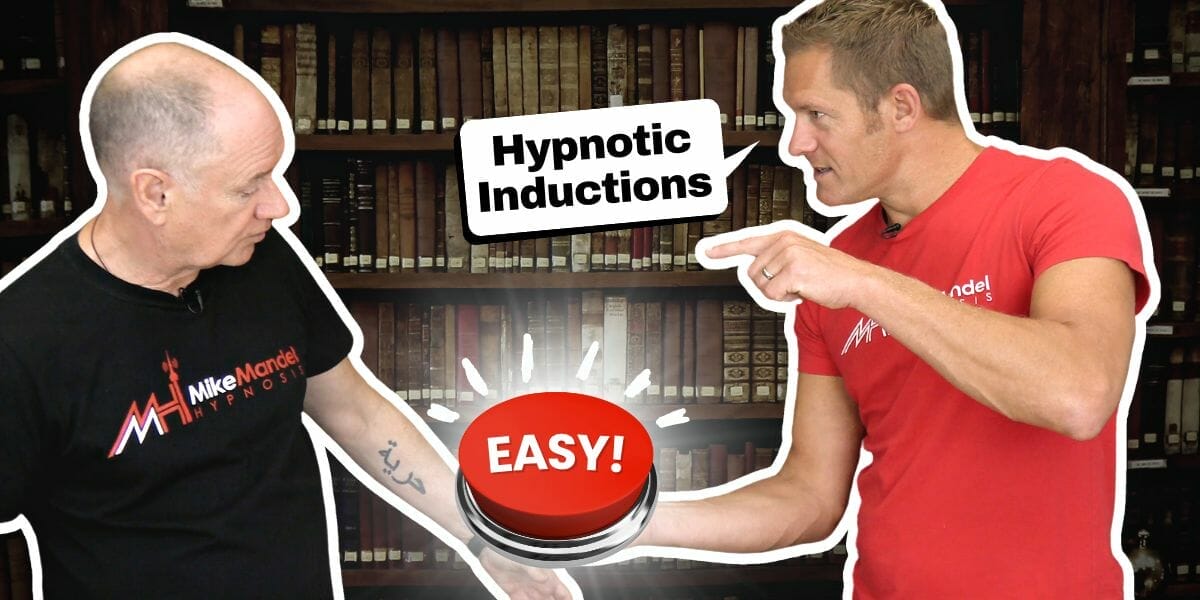If you want hypnotic inductions to be second-nature to you, keep reading this blog post!
Back in the day, hypnotic inductions were complicated. Milton Erickson (who we believe was the best hypnotist who ever lived) debuted his hand levitation induction in 1929 at Clark Hull Seminar. With this induction, the hypnotist would guide the subject's hand to rise up with direct suggestion.
It does create a memorable experience for the subject, but it's a heck of a lot of work with complicated instructions from the hypnotist.
Almost 100 years have passed since Erickson premiered his hand levitation induction. Since then, we have been able to identify the essential principles for any induction to be successful as well as a Mike Mandel “Inner Secret” that makes this induction ridiculously easy. Be certain it will work for you.
These essential principles are built around the well-established hypnotic phenomenon of a “cataleptic limb.” When a person is in trance, if you were to pick up their arm, sometimes it wouldn't fall back down. It would instead hover in the air with a waxy immobility.
In Erickson’s hand levitation induction, the hand and arm are exhibiting catalepsy. Like we said, catalepsy creates an extremely memorable experience for the hypnotic subject. They watch or feel their body moving with an instruction that didn’t originate from their own thought process or idea. It can feel surprising, interesting, funny, and it is essential to creating an experience that ratifies the hypnotic session for the subject.
In this post and accompanying video, we will share these four essential principles so you can be free of complex instructions and begin to have more fun with any induction you choose from now on.
Hypnosis Principle #1: You Need a Willing Subject
The truth is, sometimes people can feel uncertain or anxious regarding hypnosis and what going into a trance will feel like. Any worries, irrational fears, or misbeliefs about hypnosis can create something called resistance.
A more resistant person might not fully understand what they will experience, how hypnosis works, what a trance is, or they might have misrepresented opinions about hypnosis.
This distrust in the process (or in the hypnotist) can create a wall of resistance that will keep them from experiencing hypnotic trance.
So how do you know if a subject is willing? There are no cut and dry answers, but here are some tips to help you determine if a subject is willing or likely to resist:
- Willing subjects are willing to pay for your service and often independently seek and find you.
- Willing subjects or practice partners can often be found in hypnotist communities such as our facebook group “MMHA Engage”, which we run for our students. This is true because many hypnotists are great hypnotic subjects and fully recall what it feels like to practice in the early learning stages of becoming a fantastic hypnotist.
- Willing subjects are cooperative. When you say, “put your feet flat on the floor, take a deep breath, and close your eyes on the exhale” (as an example of a compliance set), they do it without any resistance.
- The most willing subjects are often at “threshold” which we define as: “Something needs to change, it needs to be me, it needs to be now.” (Read: The Principle of Threshold: How To Know if Someone is Ready To Change.)
Hypnosis Principle #2: Establish Rapport
We’re obviously more willing to accept suggestions and directions from a person we like. In the field of hypnosis, there is a word for that. We call it rapport.
It’s one of, if not the most important component of a successful therapeutic setting. Without rapport, it’s nearly impossible to achieve any results with hypnotherapy. This is true for every kind of therapy, not just hypnosis. A client must like the therapist and feel that he or she has their best interest at heart for the therapy to work. Otherwise, it’s just a waste of time for both.
“Rapport is the glue that holds trance together.” - Mike Mandel
Here are a few ways you can use to build rapport:
- Mirror and match your subject's body language, vocabulary, and vocal tonality in a subtle way that compliments the person you are interacting with.
- Imagine and pretend your subject is the most important and interesting person in the room. This results in full attention (and often compassionate) listening that instantly builds trust and human connection.
- Rapport builders may also use double-binds in order to help the subject overcome internal barriers that would create resistance. For example: “would you rather sit on the trance chair or on the hypnosis chair?” Note: Both options presume the person is going into hypnosis/trance anyway. That removes objections and resistance (Read: How To Use Double Binds To Get What You Want).

Test Drive Our Training
World Class Training. Test Drive with No Credit Card
Hypnosis Principle #3: Fixation of Attention
Focus is everything when it comes to hypnosis.
Most non-hypnotists may think of a swinging watch and the classic line, “You’re getting sleepy…” This is one example of using of eye fixation to direct the subjects attention.
But attention can be directed in many other ways. Did you know the brain doesn’t know the difference between something you imagine and something you see? Knowing this, hypnotists can fixate attention using their subject's imagination in creative ways, such as:
- Imagining a swinging pendulum whose appearance and rate are controlled by the subject (a visual approach).
- Imagining a metronome in the same way as above (could include sound effects for an auditory approach).
- Imagining that they are submerging a buoyant tennis ball in a bucket of warm water and watching it “pop” back up to the surface (an imaginative kinesthetic approach).
For a more thorough explanation of the kind of guided imagery used by many hypnotists, read Hypnotic Revivification: An Easy First Step in Learning Hypnosis.
Hypnosis Principle #4: Create an Experience
As we mentioned earlier, it is essential to create an experience the subject can look back on and recall, “Wow, that was profound.” This ratifies and validates the entire experience.
With Erickson’s hand levitation, it was the fact that the hand shot up like a rocket after careful and often time-consuming instructions.
Here It Is, Mike Mandel’s Inner Secret to Make the Hand Induction Easy:
Mike's Hand De-levitation Induction is exactly what it sounds like. The hand will sink down. Can you see how this makes gravity work for us instead of against us? That is one of the reasons it is so clever and easy. You can also make the connection that, “as the hand sinks, the subject is sinking deeper into trance.”
Here’s a brief outline of how it would look in practice. With a willing subject and rapport established:
- Hypnotist lifts hand and places it in the air at about shoulder height.
- Hypnotist says, “eyes closed now”
- Hypnotist begins to do the induction suggestions of the hand getting heavier
- Hypnotist makes a link utilizing the falling hand to their advantage to either draw the subject deeper into trance or possibly install a new resource
To be certain you learn and truly understand how this induction works, watch the video below to see it demonstrated.
And that’s that! It can be that easy and it adds the benefit of giving the hypnotist a powerful visual gauge that the induction is working as the hand sinks.
Come Join Us!
When you are ready to continue your journey toward becoming world-class hypnotist, we'd recommend starting a 100% free Test Drive of the Mike Mandel Hypnosis Academy. It's the easiest way to get started learning hypnosis.
Start doing hypnosis today. Click here to get started with the Mike Mandel Hypnosis Academy.


